A fascinating behavior that humans seldom see. I’ve only observed it twice.
Shrikes are well known for impaling prey on sharp objects as a means of caching food and as an aid for tearing prey apart since their small, weak feet are inadequate for assisting in the task. The unique behavior is also thought to allow them to take advantage of toxic or chemically noxious prey (monarch butterflies and certain toads for example) because allowing such food items to “percolate” for a few days after death causes the toxic substances to degrade and become harmless. This complex and gruesome (to humans) behavior has earned shrikes the somewhat unsavory nickname of “butcher birds”. They’re also commonly referred to as “wannabe raptors”.
In my experience shrikes typically impale their prey deep in wooded thickets or similar habitats so the behavior is difficult to observe and even harder to photograph. But some years ago I was able capture this young Loggerhead Shrike impaling a dragonfly on a sharp twig on Antelope Island. It seemed obvious to me that ‘he’ was doing it for the practice because he repeatedly impaled the same dragonfly on the same twig.
Understandably the photos are cluttered with branches and twigs and I was close so I could barely fit him in the frame (all but one of these photos are uncropped) but the behavior is clearly documented. I posted other photos of this bird long ago but this series is new to my blog.
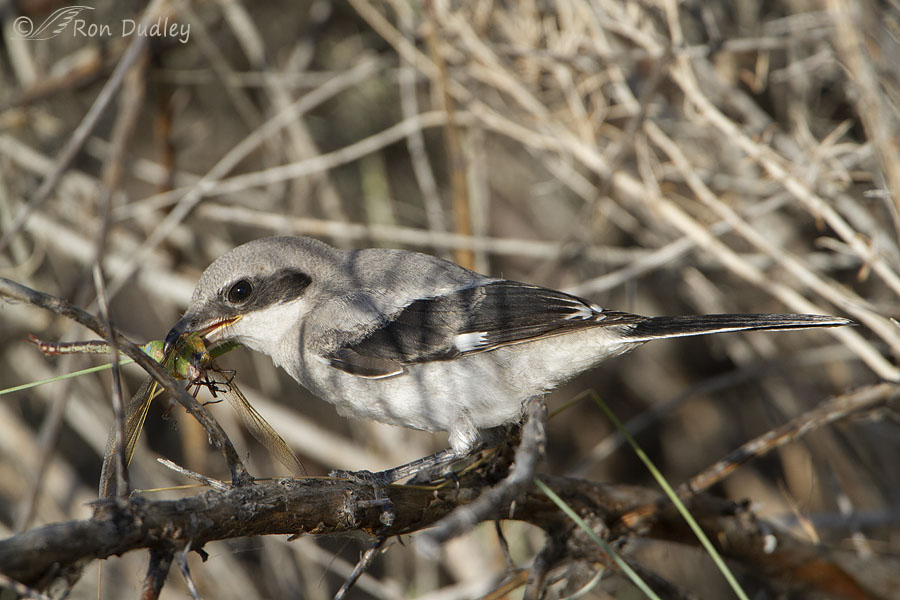
He spent some time looking for an adequately small and sharp twig to impale the dragonfly on and here he’s spotted a near-perfect candidate. Can you pick it out in all the clutter?
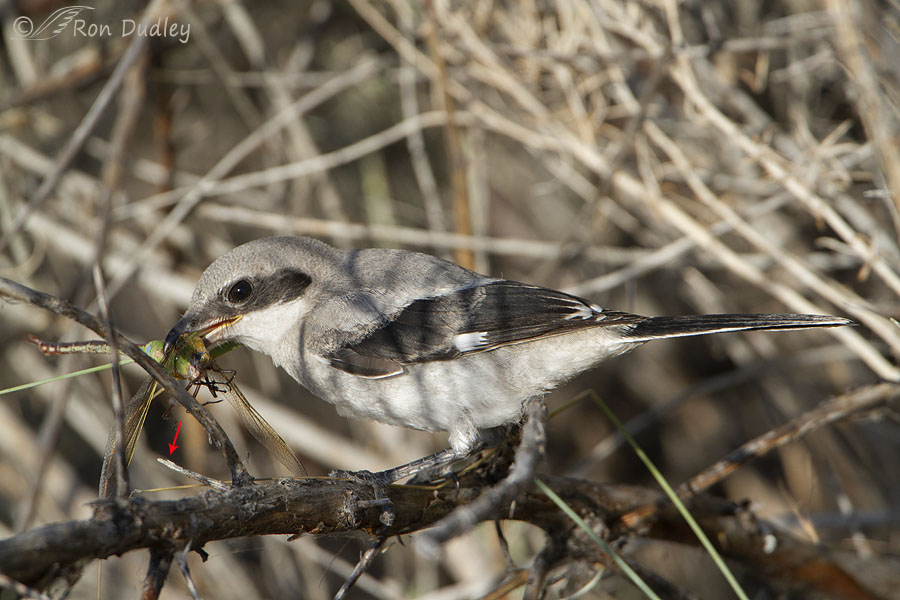
In this version of the same photo I’ve marked it with a small red arrow.
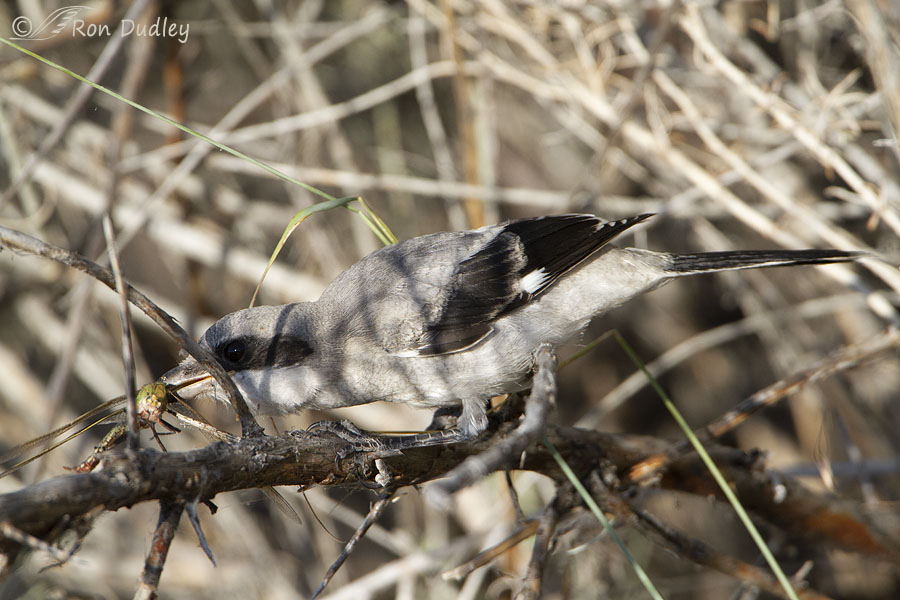
He reached far forward to get the dragonfly at the tip of the sharp twig and then…
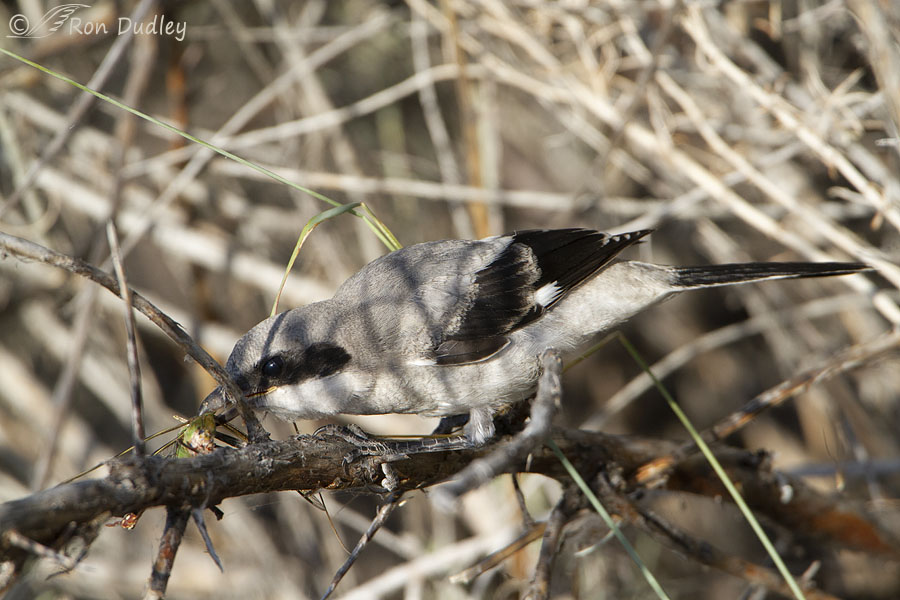
slowly pulled it down the length of the twig during the impaling process.
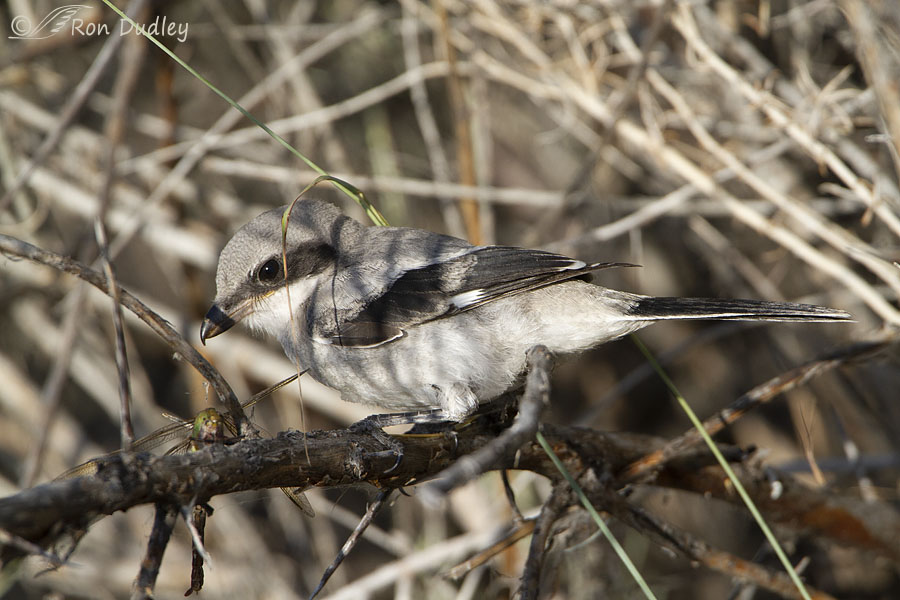
Then he carefully checked out his handiwork, apparently to see if he’d done it properly and the dragonfly was secure..
But there’s a caveat. Shrikes sometimes impale their prey and other times they wedge it in narrow V-shaped forks and I’m not sure which of the two occurred here. It appears to me that the dragonfly could have been wedged or it was imperfectly impaled or both. Either way it worked, so the dragonfly was effectively held in place on or next to the sharp twig.
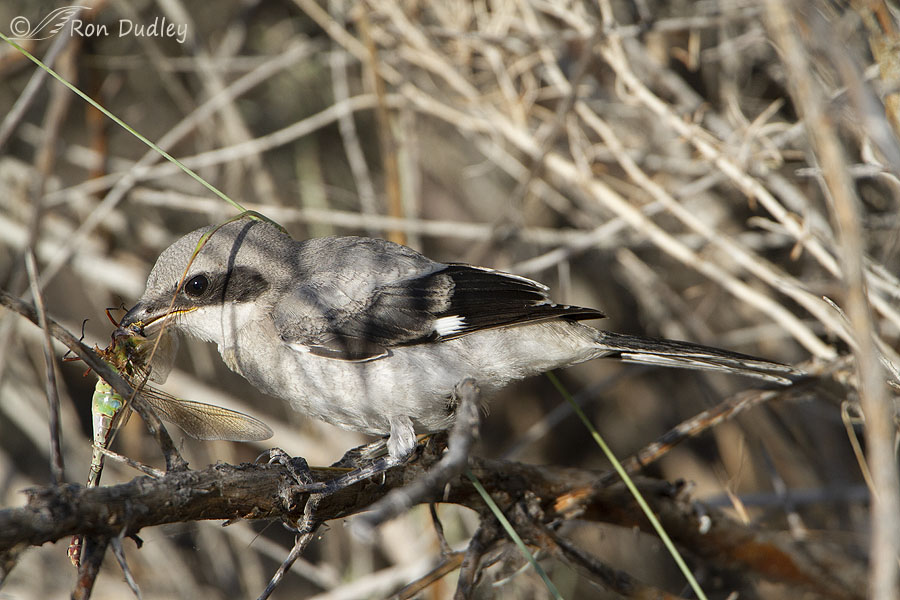
Once he was satisfied that he’d performed the tricky task properly he pulled the dragonfly off of the twig and then…
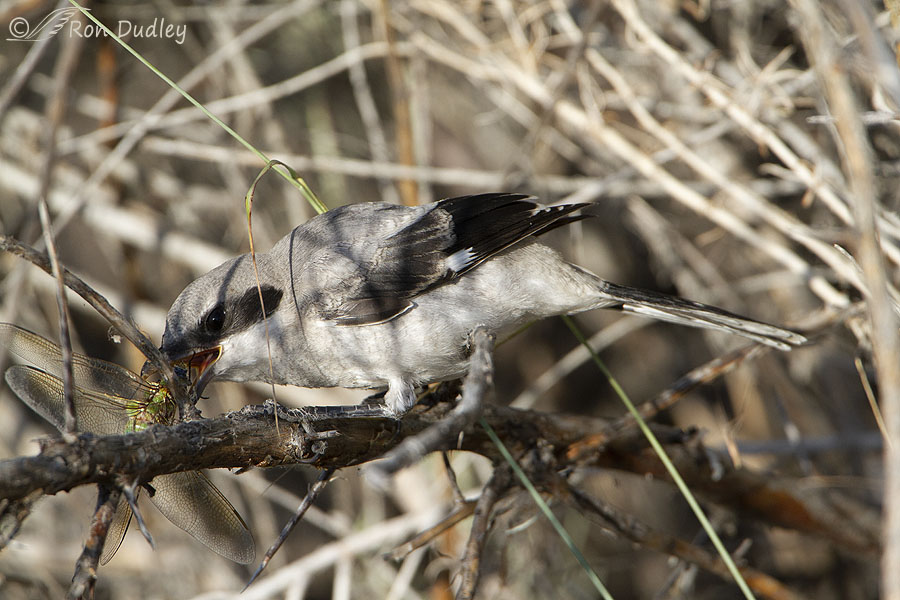
impaled it again on the same sharp twig. After this photo was taken he pulled his head away from the impaled dragonfly to make sure it was properly and safely secured and then he…
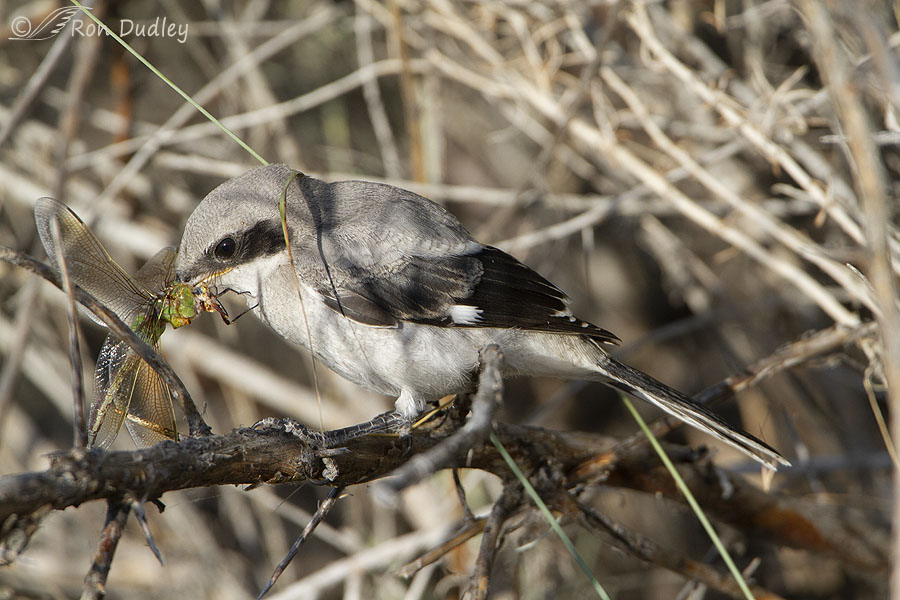
reached down retrieved it a second time. After impaling the dragonfly a third time he…
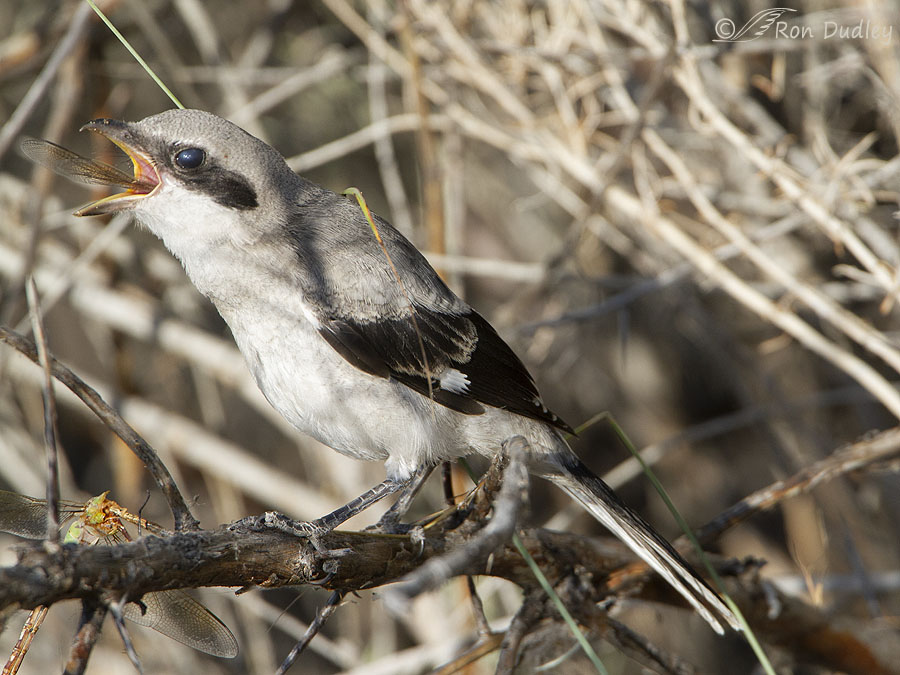
used the leverage provided by the impaled dragonfly to pull a chunk off and gobble it down.
I guess he figured he’d had enough practice.
Ron
PS – Many many thanks to readers for providing an incredible amount of valuable feedback on yesterday’s post about cataract surgery. I was blown away by all the responses providing exactly the kind of information I was fishing for. Based largely on that feedback I’m pretty much convinced that having the procedure done fairly soon is the smartest decision for me.


I just saw my first shrike last week. This is a fantastic series of shots. How cool to watch this. Vlad the Impaler!
I got a chuckle out of your last sentence, Beth.
Ron, Another outstanding series! I love reading your blog with the incredible photos you take to illustrate animal behavior. You’re clearly a life-long educator who seems to just get better and better with time and experience. Thanks for sharing your skills and knowledge in such a delightful way!
I echo that! What a great series. I learn something new every time!
Thank you, Kellie.
Your comment means a lot to me, Steve. Thank you.
Ain’t Nature grand? 🙂 (Well, maybe not for the dragonfly…) Darwin certainly had the right idea to spend much of his time studying birds and their behaviors. This is a phenomenal series for reasons too numerous to mention!
Thank you, Marty.
Wow, an incredible series!
Thanks, Kris.
So much remarkable in these photos:
-the Loggerhead Shrike itself, a near-threatened species
-noting that it is a juvenile (I wouldn’t have known)
-impaling/wedging its prey (tool using)
-eating that wing, or is that a gag reflex?
-exhibiting its tomial tooth
-nictitating membrane with eye catch
-all those sharp shots through the twigs
Percolating bugs.
You’re very observant, Lyle.
Juvies look similar to adults but their grays have a brownish tinge to them.
I have no reason to think this isn’t tool using. Just because the tool isn’t held in the hand or some other body part shouldn’t matter IMO.
He was eating more than just the wing. There were body parts attached to it.
Yes, in the last shot his eye is clouded by the membrane.
Great capture. We have honey locust and black locust around Red Butt Gully behind our house, these trees have thorns. We use to have a shrike that would impale food on the thorns in one of the trees that had a nice view of the hillside. Some times there would be a nice collection of food left for a few days on the thorns. One day, I also watched as a magpie raid the shrike’s pantry. That was nearly 30 years ago and I have not seen a shrike in the gully since. I feel with the development 25 years ago of the large fields that were along Military way removed habitat required to support many of the wildlife we use to have on my street just a few blocks south. Ahh progress……….
Progress stinks doesn’t it, April. And there’s a LOT of stink these days.
In case you or your readers are interested, the dragonfly is a Common Green Darner (Anax junius). Cheers
Good to know. Thanks, Richard.
Thanks for the ID — I’ve got a photo of one that spent a day on an angel vine in my patio 7 years ago, just an amazing-looking creature! And have seen only one or two since, so I got lucky back then.
What an amazing thing to see and document. Practice makes perfect indeed – with a ‘delicious’ reward.
And what a clever adaptation for the shrike to use the twigs to compensate for a lack of strength in its feet.
I was pretty amazed to actually see it too, EC. Getting photos was a bonus, a big one.
Thanks for this series! I had no idea that these shrikes impaled their prey. How very adaptive!
Thank you, Pat.
Terrific series, so interesting to think this youngster understood practice makes perfect and had the right specimen to test his skills.That looks like one tough dragonfly, which I always think of as such a fragile, delicate species. Possibly a different prey item would not have stood up to the repeated behavior.
I agree, Chris. How do they know they need to practice? (assuming that’s what he was doing and I think it was).
This is a great series Ron. I’ve seen lots of photos of impaled prey before, and over the years a handful of times I’ve seen prey myself that was likely left by a shrike (mostly on barbed wire fences in Texas). But I’ve never seen a series of the actual impaling. Really fascinating. Thanks for sharing these.
To see the impaling behavior is pretty rare for me too, Bill. The only other time I observed (and photographed) it the shrike was impaling a grasshopper on barbed wire in Montana.
Interesting! 😀 At least the dragonfly didn’t disintegrate after several impaling’s or wedging requiring him to retrieve it making me wonder if it was more wedged BUT didn’t seem like a very sharp angle to hold it well – it worked whatever the case. I was unaware of the “weak legs”. We have a shrike of some sorts every few years that clears out the bird feeders and has used the thorns on a russian olive or similar thorned shrub to impale it’s prey.
Go for it on the cataract surgery…..😉
Judy, perhaps the dragonfly was wedged the first time but in that last photo it appears to be obviously impaled on the twig.
Agree!
What an interesting, educational, and outstanding photographic series. Even at 6:06 am and only a couple sips of coffee I immediately knew what twig he would use. Thanks for the biology lesson in the first paragraph. I have taken many photos of shrikes, but only calmly perched. I have never caught one in the act of killing or eating prey. Thanks for posting this.
Everett, I’m glad that you see a lot of shrikes. Loggerhead Shrikes are in big trouble in much of their range, including around here. They used to be one of the most common birds I photograph on Antelope Island but now I seldom see them there.
What a great series. I’ve seen impaled prey, and I’ve seen the hunting, but I’ve never seen this. Lucky you!
Thanks, Shoreacres. Yes, it’s significantly easier for us to spot prey that has been impaled than to actually observe the impaling behavior.
Totally agree!